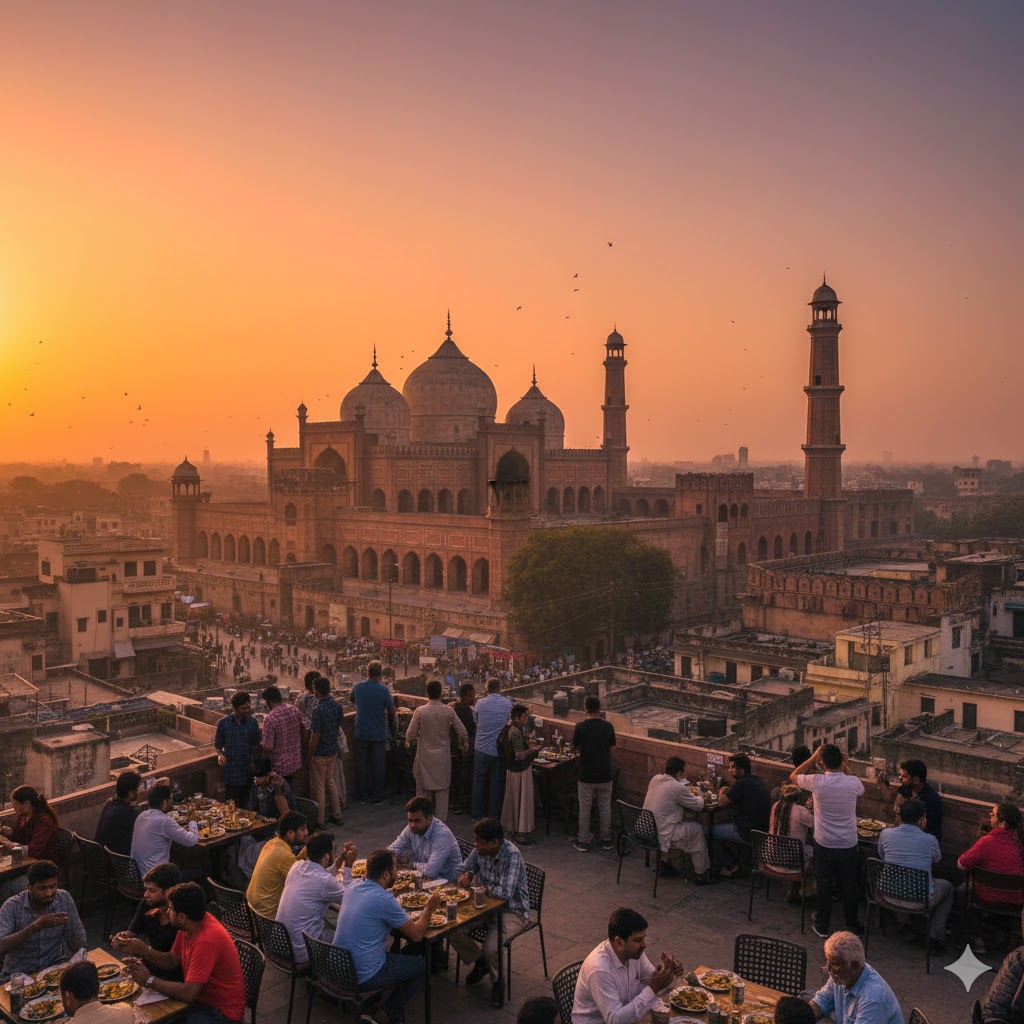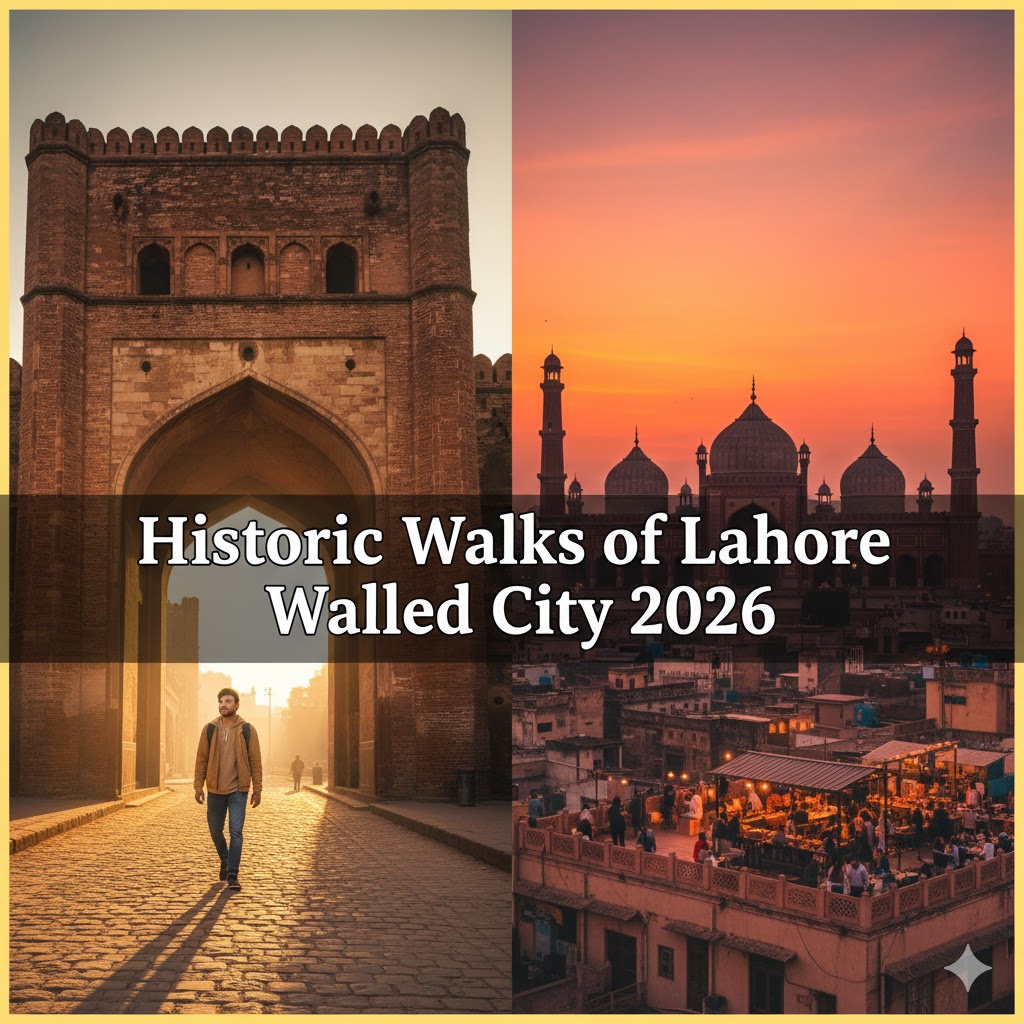Explore Timeless Mughal Heritage
If there’s one place in Pakistan that still breathes history, it’s the Historic Walks Lahore Walled City. This ancient core of Lahore, also known as Androon Lahore, is where heritage, spirituality, and artistry intertwine. From Mughal mosques to narrow lanes echoing with street calls, these Lahore heritage walks reveal a living museum that never sleeps.
Lahore — the heart of Pakistan and the keeper of centuries-old stories — thrives within the narrow lanes of its Walled City, also known as Androon Lahore. Walking through its cobbled streets is like turning the pages of a living history book. Every turn reveals Mughal arches, Sikh havelis, British-era facades, and the aroma of spiced kebabs floating through the air.
The Historic Walks Lahore Walled City have become a hallmark of cultural revival, inviting locals, historians, photographers, and travelers to experience the old-world charm that shaped Pakistan’s identity. This article takes you on a 360° immersive journey — exploring hidden gems, iconic landmarks, local legends, food trails, and architectural treasures — all within Lahore’s ancient heart.
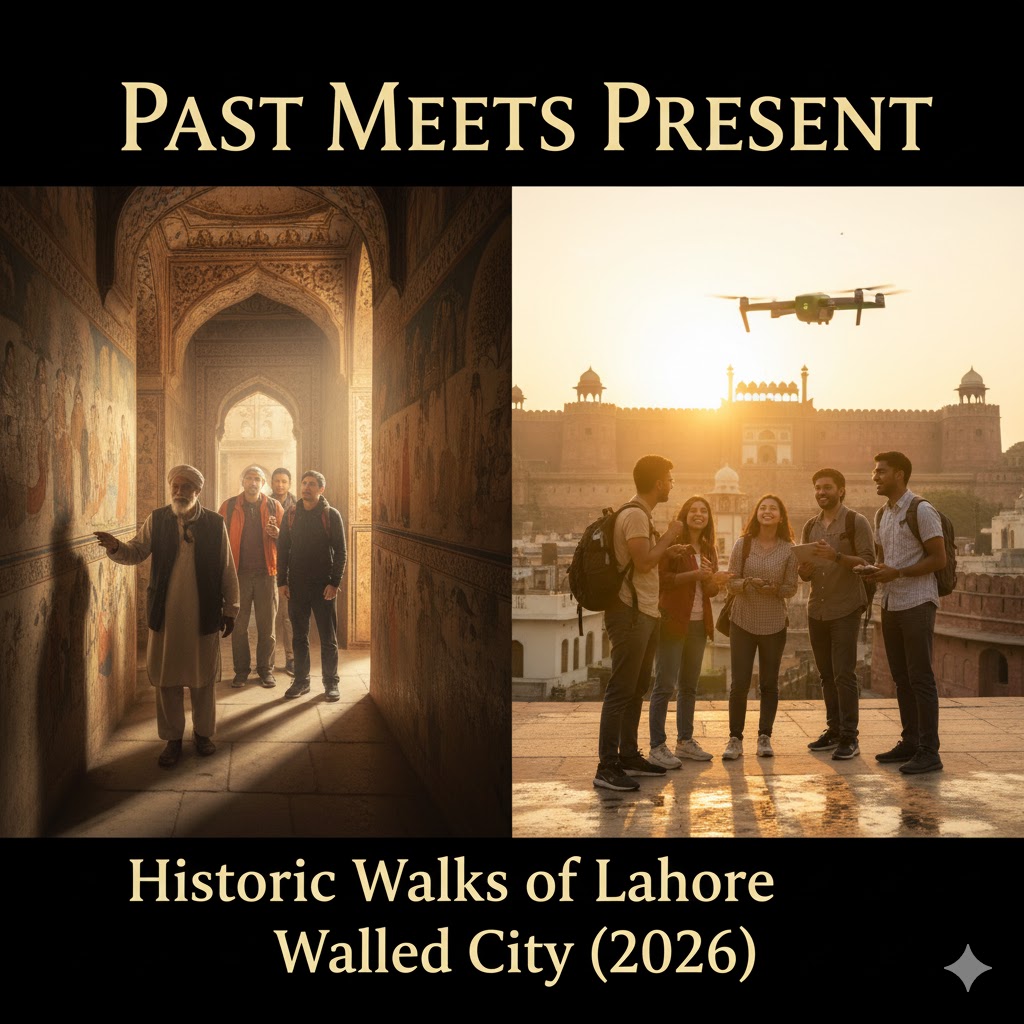
🧭 Table of Contents
- Introduction: Lahore — The Heartbeat of Heritage
- The History of the Walled City
- Entry Points — The Thirteen Gates of Lahore
- Delhi Gate to Shahi Hammam: A Cultural Corridor
- Masjid Wazir Khan — Jewel of Mughal Architecture
- Fort Road & Food Street — Where History Meets Flavors
- Shahi Qila (Lahore Fort) — Echoes of Empires
- Badshahi Mosque — Symbol of Majesty
- The Royal Trail (Shahi Guzargah) — Walking Like Kings
- Havelis & Hidden Courtyards — The Forgotten Mansions
- Local Experiences & Street Markets
- Cultural Events & Heritage Festivals
- Best Time to Take a Historic Walk
- Travel Tips, Entry Passes & Guided Tours
- FAQs: Historic Walks of Lahore
- Conclusion
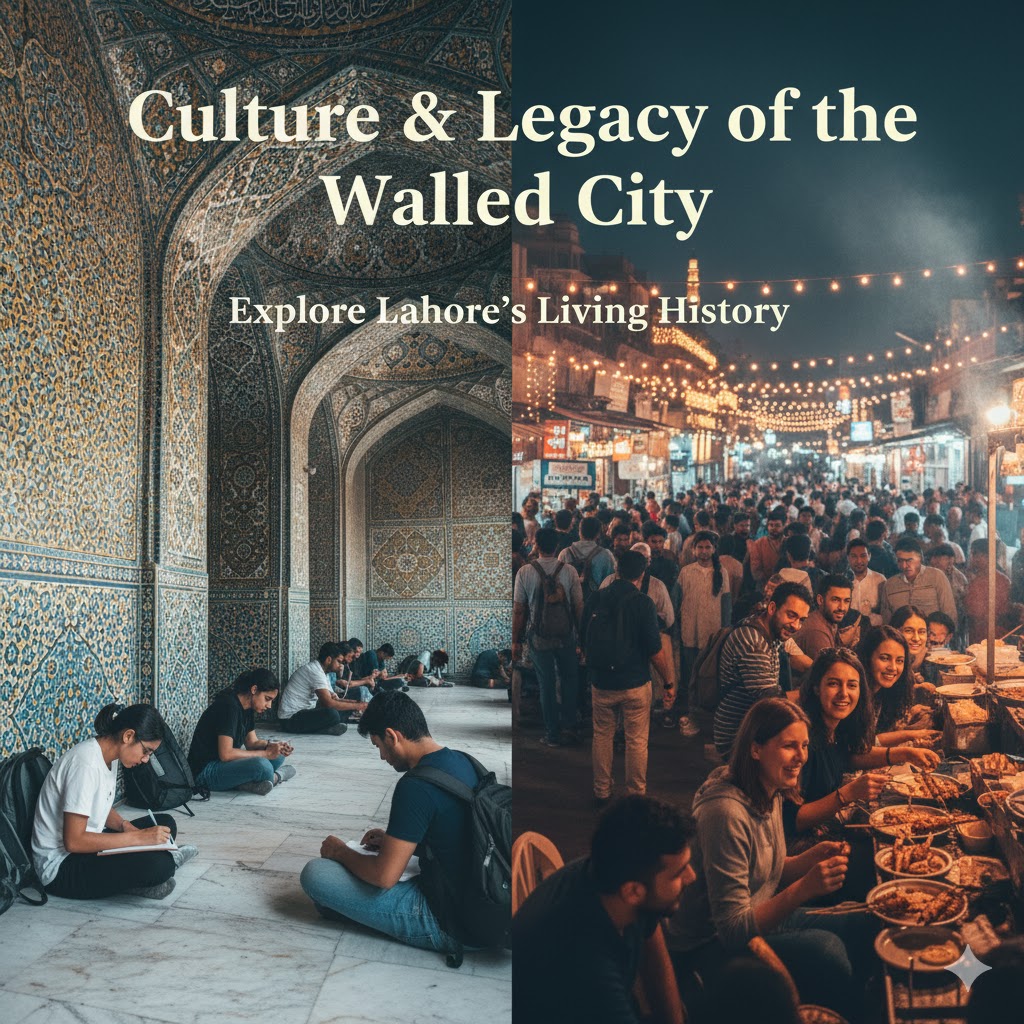
1. Introduction to the Historic Walks Lahore Walled City
To walk the Historic Walks Lahore Walled City is to relive centuries of civilization in one afternoon. The air carries aromas of seekh kebabs and incense, while echoes of the call to prayer merge with street chatter. This immersive journey is part spiritual, part architectural, and entirely unforgettable.
“Jinnay Lahore nai vekhya, o jamya nai” — a Punjabi saying meaning “He who hasn’t seen Lahore, hasn’t been born yet.”
Lahore’s charm doesn’t lie in skyscrapers or highways; it breathes through the cracks of its 400-year-old brick walls, where every corner carries whispers of empires gone by. The Walled City of Lahore represents the soul of the Mughal Empire, the resilience of Sikh heritage, and the artistry of local craftsmen who still preserve centuries-old techniques.
Today, heritage walks offer travelers a time machine into the past — blending storytelling, architecture, and food into a single unforgettable journey.
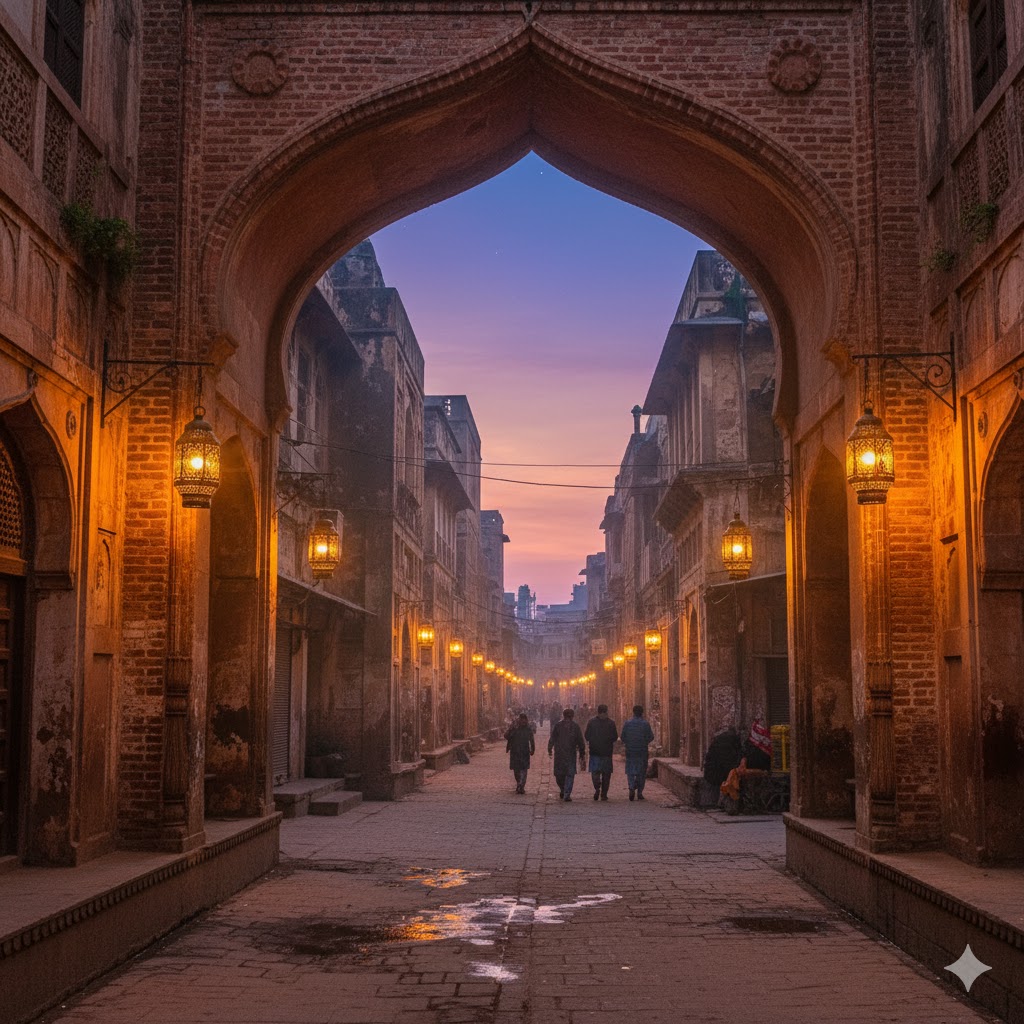
🏰 2. The History Behind the Historic Walks Lahore Walled City
Dating back to the 11th century, Lahore’s fortified city became a crown jewel under the Mughal Empire. The Historic Walks Lahore Walled City now retrace paths once walked by emperors, poets, and merchants from Persia, Kabul, and Delhi.
The foundation of the Walled City dates back to the 11th century, fortified and later expanded by the Mughals in the 16th and 17th centuries. The 13 grand gates surrounding the city once defined its royal boundaries — controlling access for traders, nobles, and travelers.
Under Emperor Akbar, the city thrived as a hub of commerce and culture. Later, Sikh Maharajas like Ranjit Singh added layers of architecture — fortifying havelis and decorating palaces. During British rule, portions of the wall were removed, yet the soul of the city endured.
Today, thanks to the Walled City of Lahore Authority (WCLA), restoration projects like Shahi Hammam, Wazir Khan Mosque, and Shahi Guzargah preserve the authentic spirit of Lahore’s heritage.
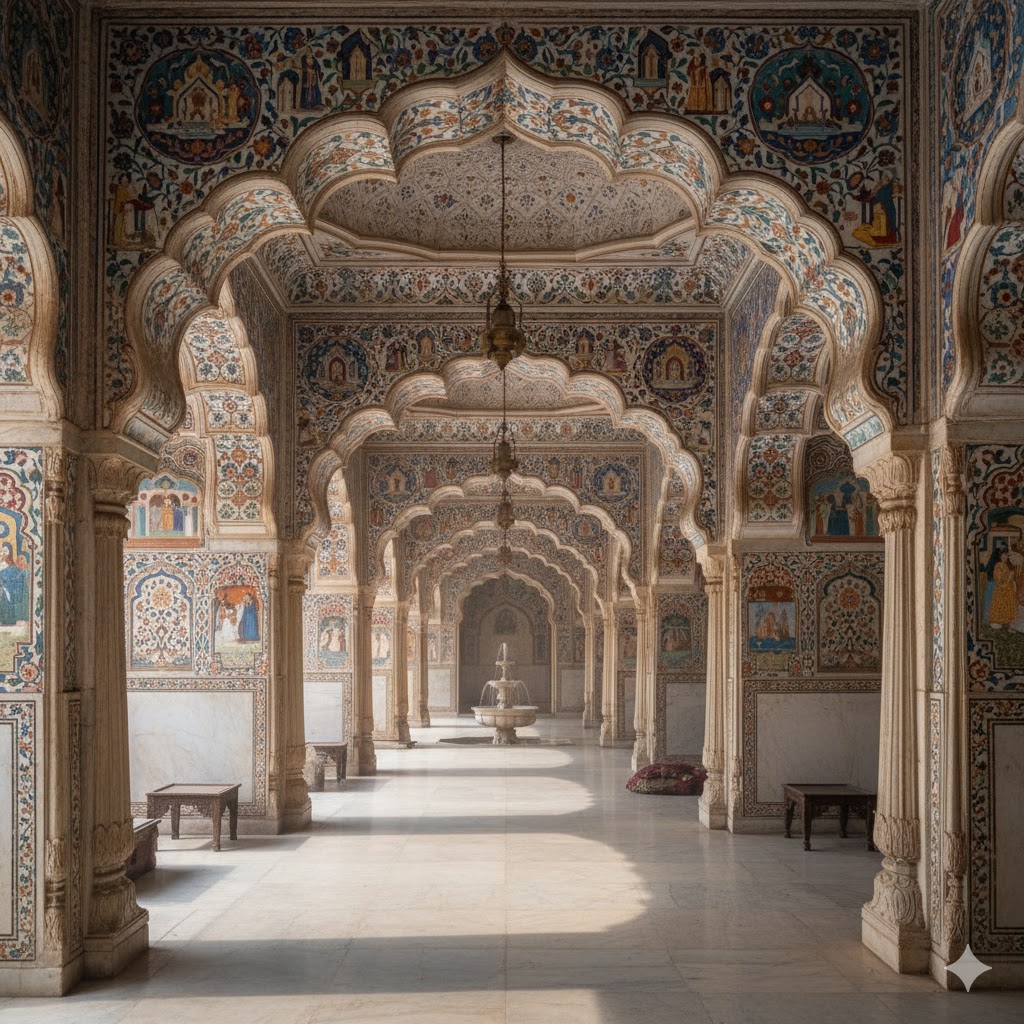
🏯 3. Exploring the Thirteen Gates — The Heart of the Historic Walks Lahore Walled City
Each of Lahore’s 13 gates tells a story. From Delhi Gate (gateway to India) to Roshnai Gate (the Gate of Lights), travelers explore how trade, art, and religion merged here.
Once encircled by thick brick walls, Lahore’s Walled City was accessed through 13 historical gates, each named after its direction or nearby landmark.
- Delhi Gate – Gateway to Mughal Lahore and main entrance for travelers from Delhi.
- Bhatti Gate – Known for traditional food and poetry gatherings.
- Lohari Gate – Named after blacksmiths (Lohars) who lived here.
- Mori Gate – The smallest gate, leading toward open markets.
- Roshnai Gate – The “Gate of Lights” near Badshahi Mosque.
- Taxali Gate – Famous for musicians and Lahore’s cultural nightlife.
- Yakki Gate – Named after the saint Zakki Shah who died defending Lahore.
- Shairanwala Gate – Associated with lions kept by Maharaja Ranjit Singh.
- Kashmiri Gate – Opened towards the road to Kashmir.
- Shah Alami Gate – Bustling hub of commerce, rebuilt after partition.
- Akbari Gate – Connected to Akbar’s royal markets.
- Mochi Gate – Known for fireworks, kite sellers, and festivities.
- Masti Gate – Led directly to the royal quarters and Lahore Fort.
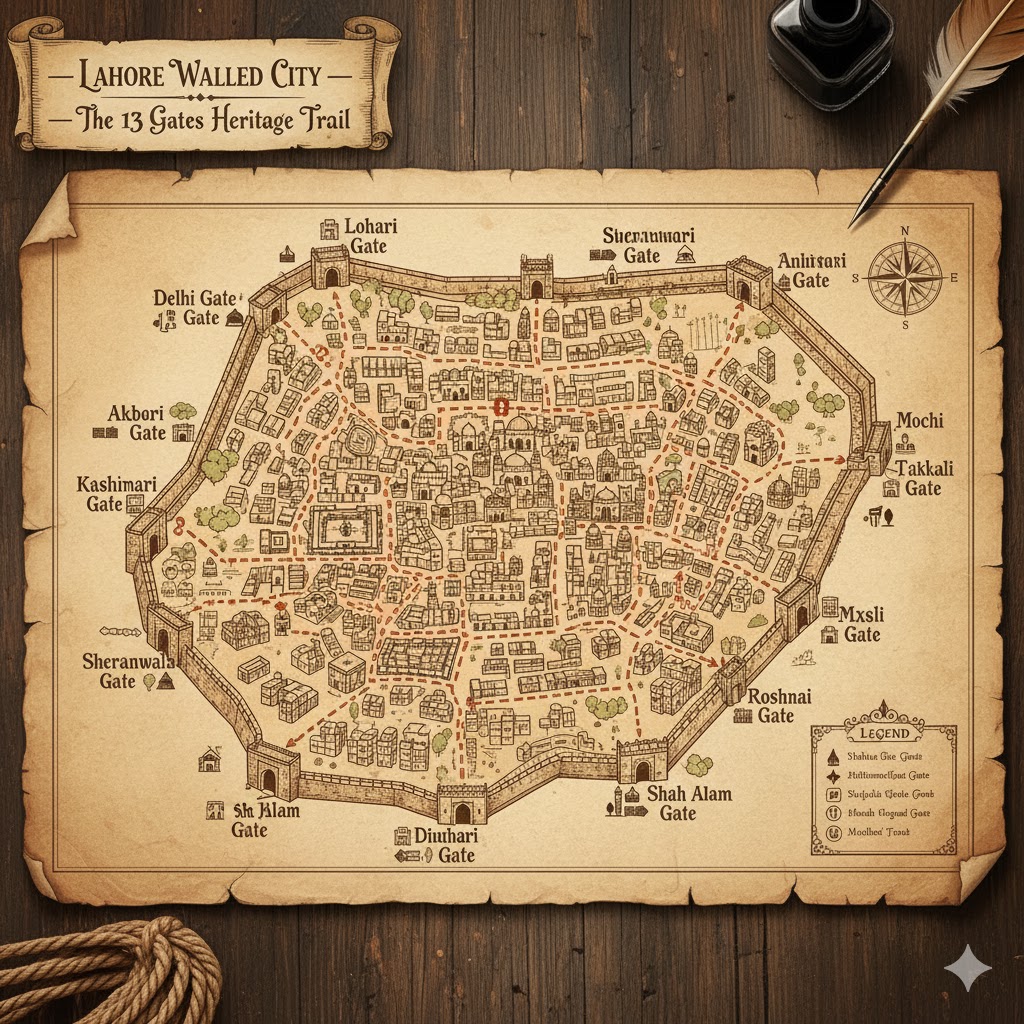
🌸 4. Delhi Gate to Shahi Hammam — Start of the Historic Walks Lahore Walled City
Begin your Historic Walks Lahore Walled City at Delhi Gate. The path leads straight to Shahi Hammam, a 17th-century royal bath restored to its Mughal-era splendor. Its frescoes tell tales of empresses and merchants who once bathed here before royal court visits.
Start your heritage walk at Delhi Gate, where you’ll step into a living museum. Narrow alleys hum with local life — rickshaws, vendors, spice-scented air, and artisans carving brass pots.
A few minutes into your walk lies the Shahi Hammam (Royal Bath) — a 17th-century Turkish-style bathhouse built during Shah Jahan’s reign. Its frescoes, steam chambers, and domed ceilings have been restored using original pigments. Visitors can see 3D projections that recreate Mughal bathing rituals, an absolute treat for history lovers.
Just outside, local guides narrate tales of merchants who once rested here before visiting the Emperor’s court.
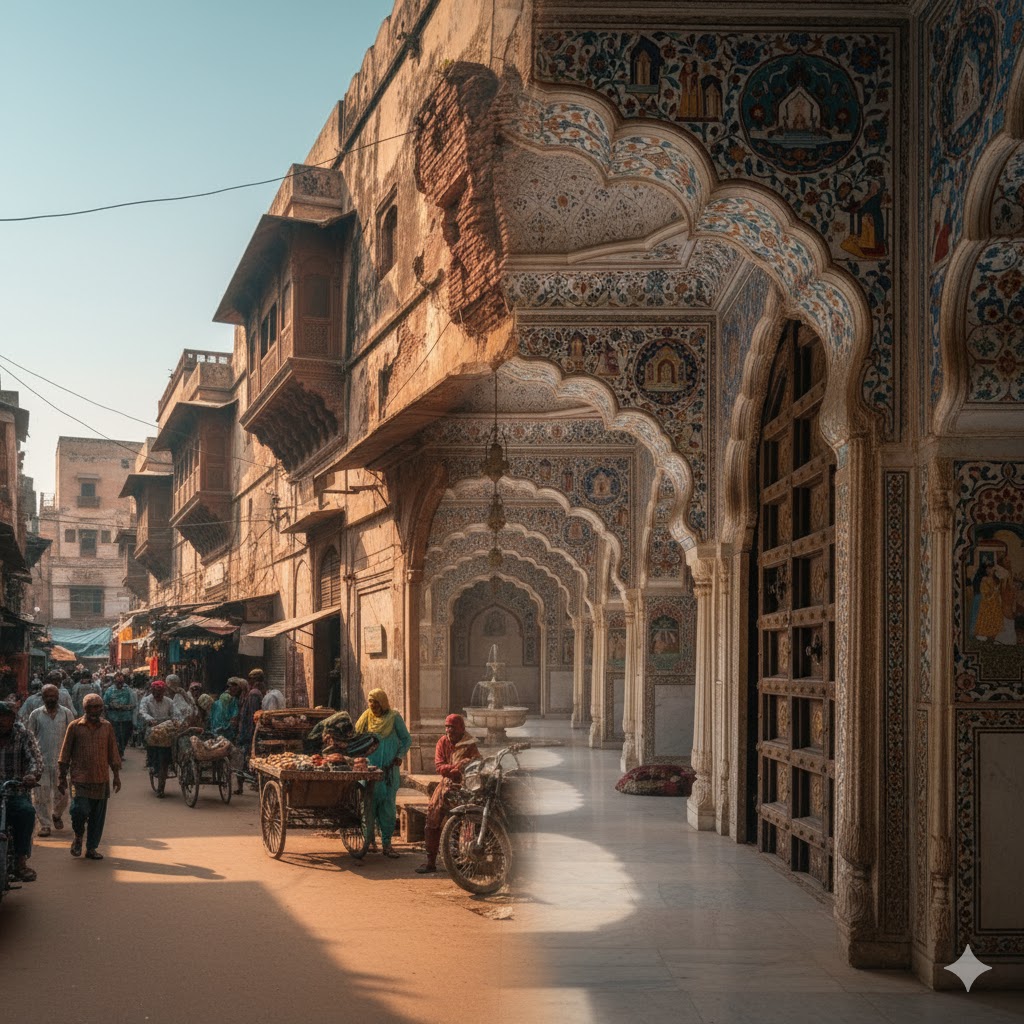
🕌 5. Masjid Wazir Khan — The Jewel of the Historic Walks Lahore Walled City
The Historic Walks Lahore Walled City reach their artistic peak at Masjid Wazir Khan, a mosque adorned with Persian-style mosaics and Quranic calligraphy. The colors of its domes mirror Lahore’s vibrant soul — gold, blue, and terracotta blending perfectly.
Walking deeper into the bazaar, the pathway opens to the Masjid Wazir Khan, Lahore’s architectural crown jewel. Built in 1634, it features Persian-style tile work, faience mosaics, and intricate calligraphy unmatched in South Asia.
The mosque’s courtyard offers serenity amid chaos, with the fragrance of rose water lingering in the air. Artists nearby paint miniature art inspired by its walls. Many heritage tours stop here for photography and cultural storytelling.
Must See: Explore Kalash Cultural Adventures
Source: UNESCO Lahore Fort & Shalamar Gardens Heritage Info
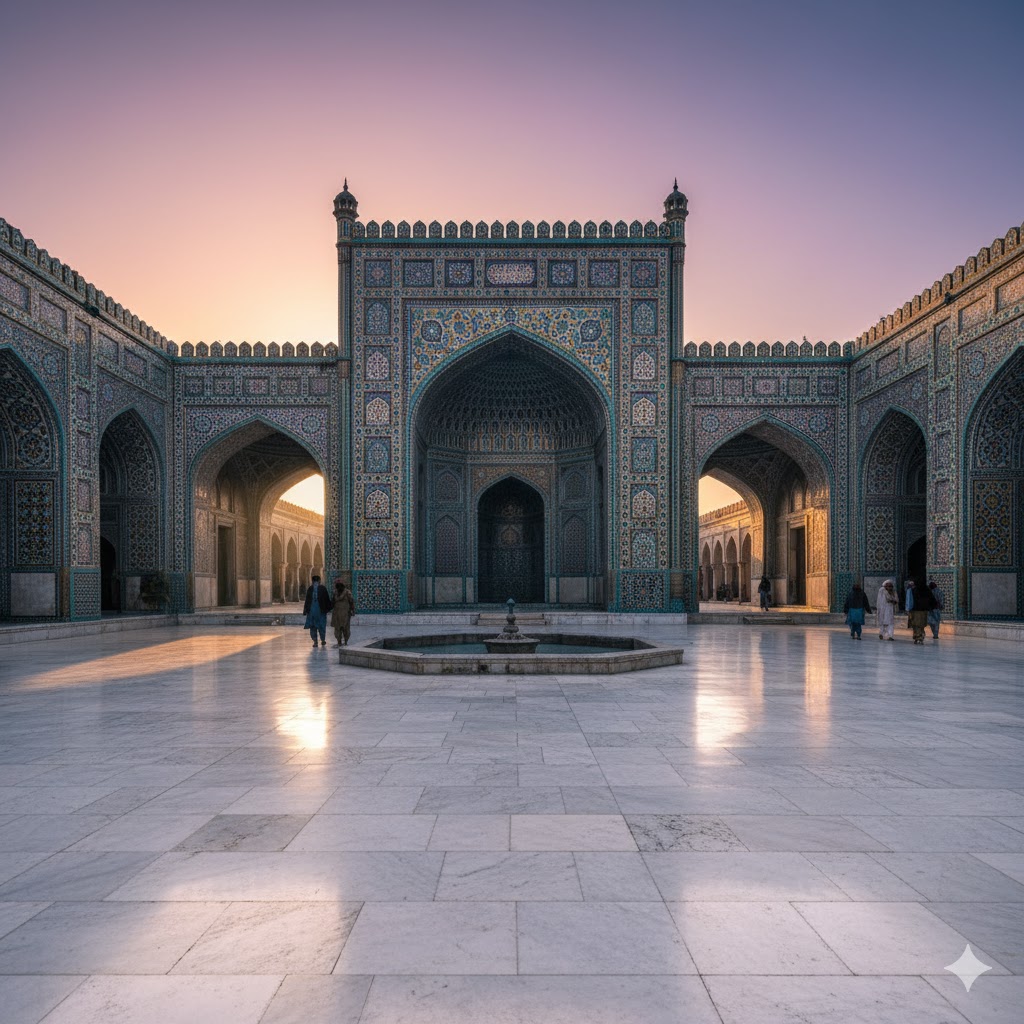
🍢 6. Fort Road & Food Street — Flavors Along the Historic Walks Lahore Walled City
Evenings on Fort Road Food Street are a must during your Historic Walks Lahore Walled City. Rooftop cafés overlook Badshahi Mosque, serving hot kebabs and the rhythm of qawwali. Food, laughter, and light — this is Lahore’s nightlife wrapped in heritage.
As you exit Wazir Khan Mosque, head toward Fort Road Food Street, one of Lahore’s top heritage dining hubs. Here, rooftop cafes overlook Badshahi Mosque and Lahore Fort, creating postcard-perfect evenings.
From Anda Shami Burgers to Payas, Nihari, Halwa Puri, and Seekh Kebabs, this food trail offers a taste of Lahore’s royal flavors. Visitors often describe it as “eating history with a view.”
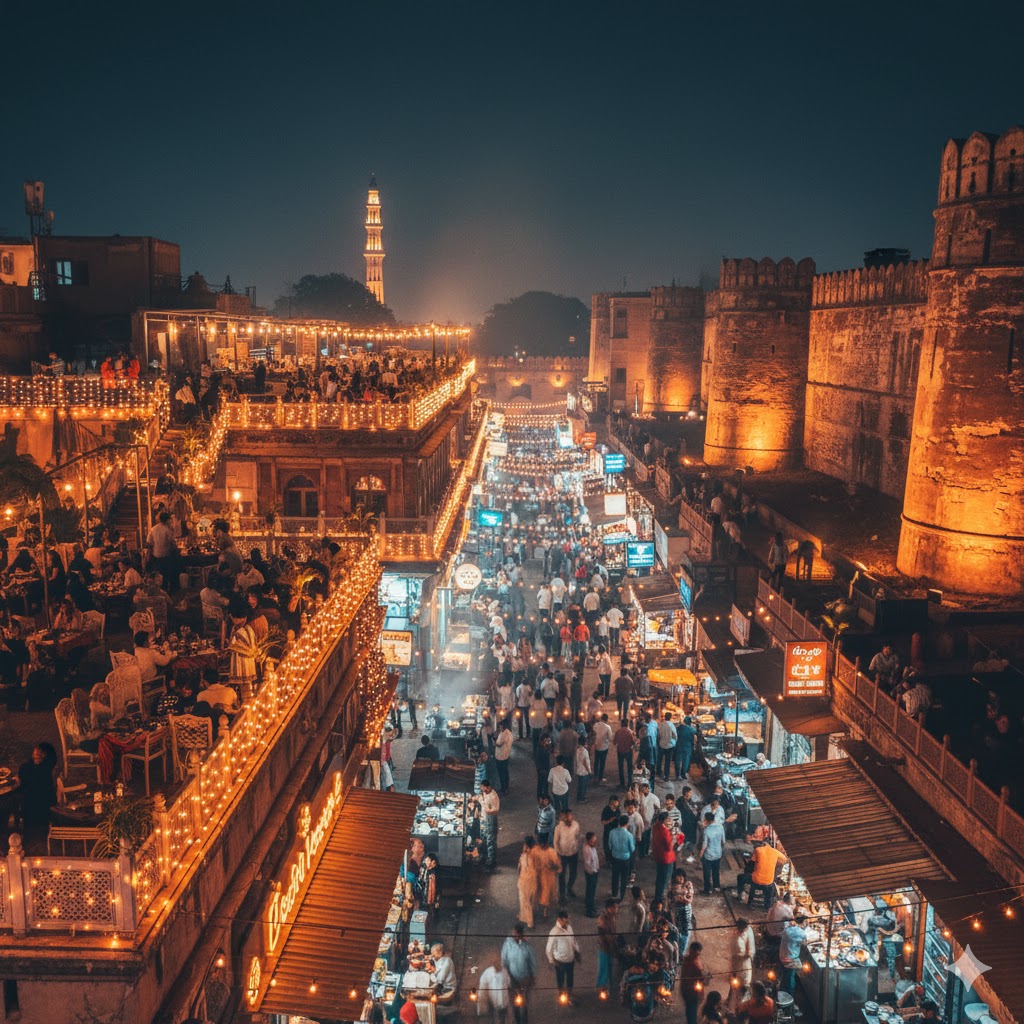
🏰 7. Lahore Fort — The Grand Finale of Every Historic Walk
The Historic Walks Lahore Walled City often end at Lahore Fort (Shahi Qila) — an imperial complex where marble palaces and mirrored halls reflect the golden age of Mughal art. Every arch and courtyard still whispers stories of emperors and poets.
The Lahore Fort, or Shahi Qila, dominates the city’s skyline with its grandeur. Expanded by Akbar and refined by Shah Jahan, it includes gems like:
- Sheesh Mahal (Palace of Mirrors) – ceilings glittering with inlaid glass.
- Naulakha Pavilion – an ivory-marble summer palace.
- Diwan-e-Aam & Diwan-e-Khas – halls where emperors addressed their courts.
The fort’s walls whisper of Mughal emperors’ power, while the elephant stairs remind visitors of royal processions.
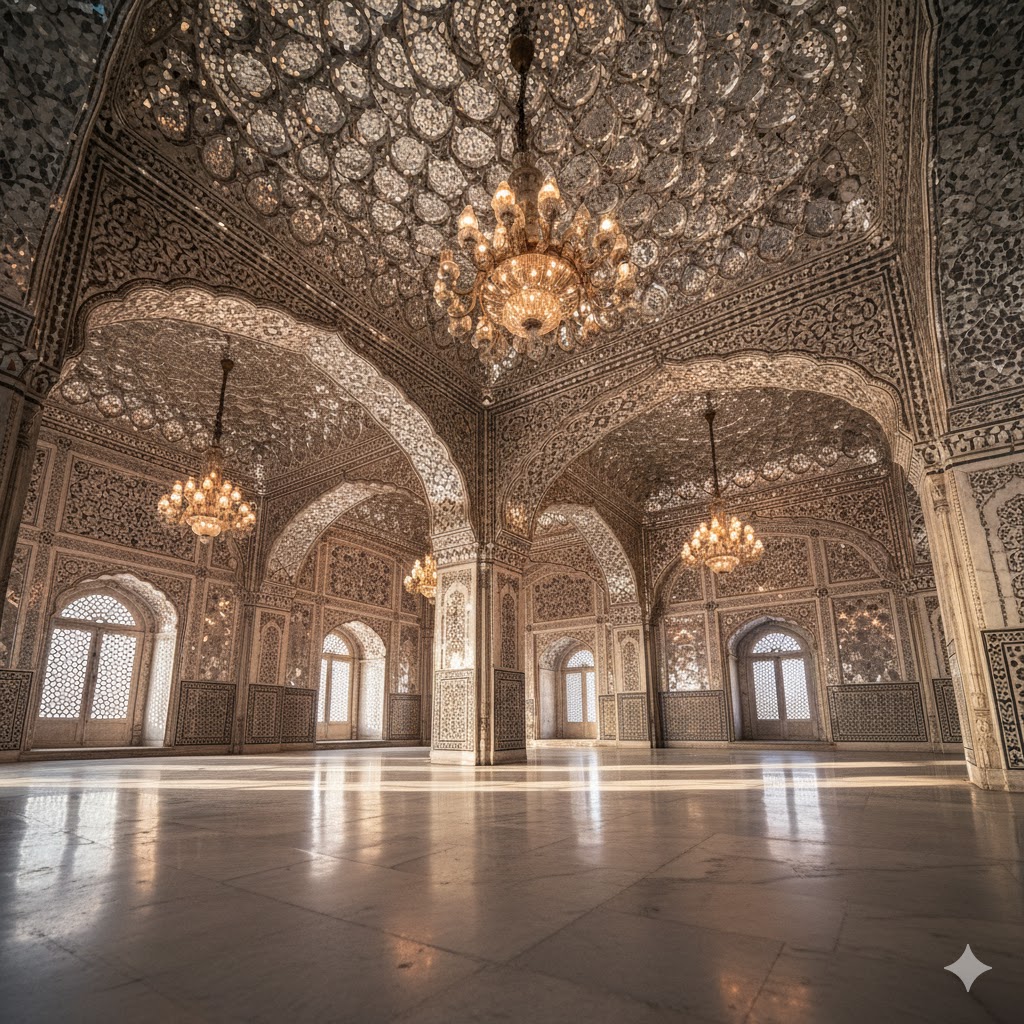
🌄 8. Badshahi Mosque — The Spiritual Heart of the Historic Walks Lahore Walled City
As you complete the Historic Walks Lahore Walled City, the Badshahi Mosque stands tall — symbolizing Lahore’s faith and resilience. Built in 1673, it glows at dusk, drawing both pilgrims and photographers from around the world.
Facing the fort is Badshahi Mosque, a breathtaking 17th-century marvel built by Aurangzeb Alamgir. With its colossal red sandstone courtyard and marble domes, it can host over 100,000 worshippers.
As dusk falls, the mosque glows under golden lights, reflecting the spiritual essence of Lahore’s skyline. Many travelers visit at sunset for the perfect panoramic shot.
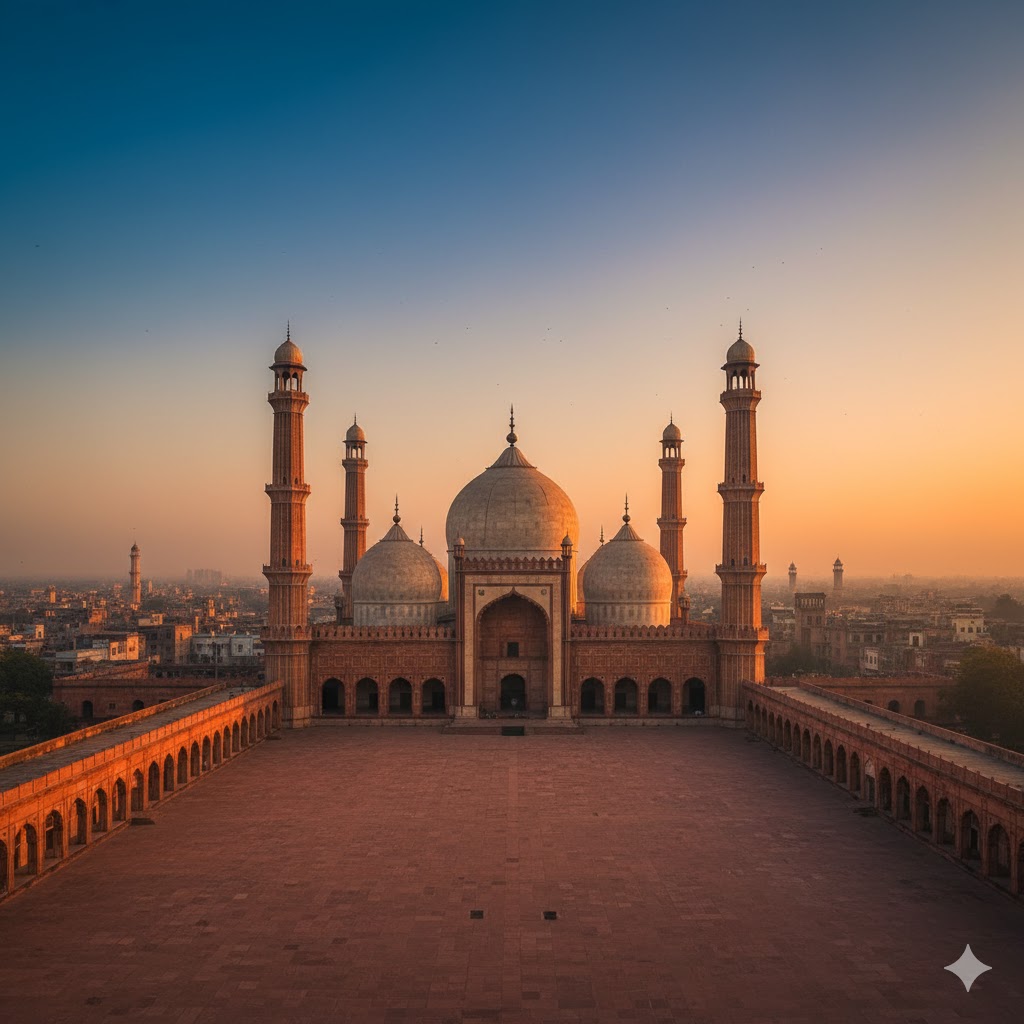
🛕 9. Havelis & Hidden Courtyards in the Historic Walks Lahore Walled City
Behind carved wooden doors, centuries-old havelis reveal Lahore’s aristocratic past. On the Historic Walks Lahore Walled City, you can visit Mubarak Haveli and Haveli Naunehal Singh, known for their ornate frescoes and quiet courtyards — each telling stories of forgotten nobility.
This historic route connects Delhi Gate to Lahore Fort, once reserved for Mughal royals. Today, it’s a restored pedestrian path lined with havelis, shrines, and antique shops.
Visitors can walk the same trail where processions of nobles, poets, and scholars once passed. Along the way, local musicians play traditional instruments — reviving the royal vibe.
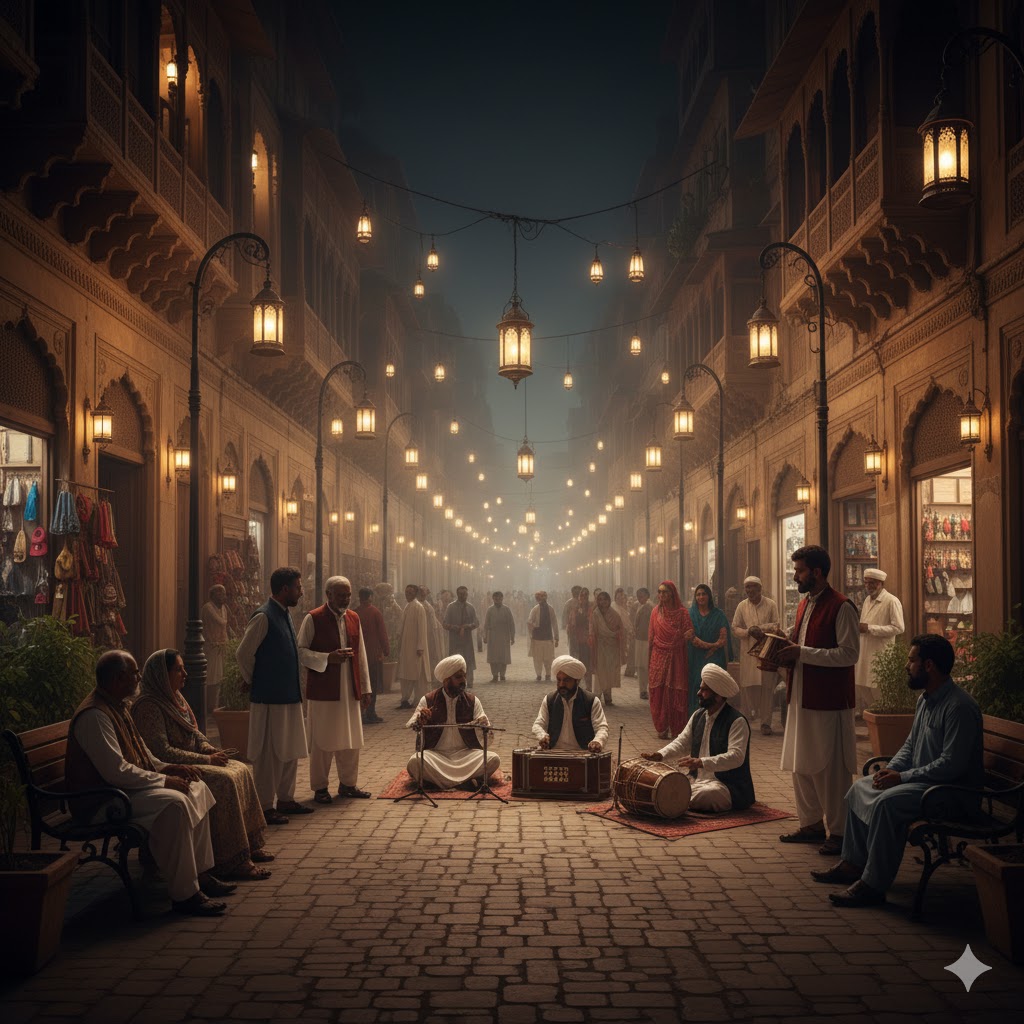
🏚️ 10. Local Experiences – Souvenirs of the Historic Walks of Lahore Walled City
No heritage walk is complete without a stop at Akbari Mandi or Kashmiri Bazaar. Local artisans craft brass, wood, and fabric souvenirs that reflect Lahore’s centuries of craftsmanship. Each purchase supports families preserving ancient skills.
Inside narrow lanes, historic mansions like Haveli Naunehal Singh, Mubarak Haveli, and Nisar Haveli showcase Mughal and Sikh grandeur.
Many havelis have fresco-painted ceilings, latticed balconies, and secret courtyards that once hosted royal guests. Some now function as cultural museums or art galleries run by heritage organizations.
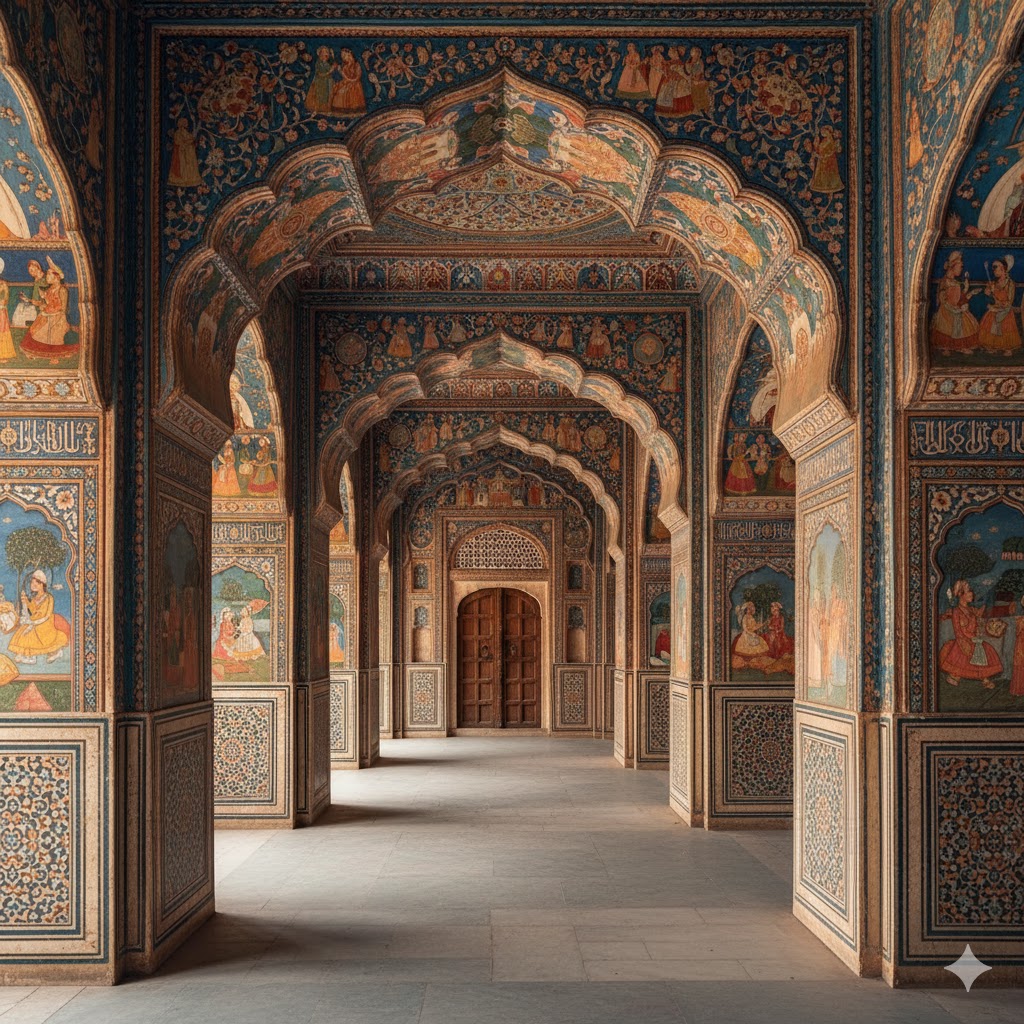
🧵 11. Cultural Events and Festivals
Annual events like Heritage Walk Lahore, Mela Chiraghan, and Basant Revival attract students, vloggers, and historians. Attending these during your Historic Walks of Lahore Walled City lets you see tradition come alive — drums, lights, and laughter filling the streets.
From Kashmiri Bazaar to Anarkali and Akbari Mandi, these streets buzz with the trade of spices, copper crafts, and traditional attire. Tourists can buy embroidered shawls, brass utensils, and miniature art — all handmade by artisans whose families have lived here for generations.
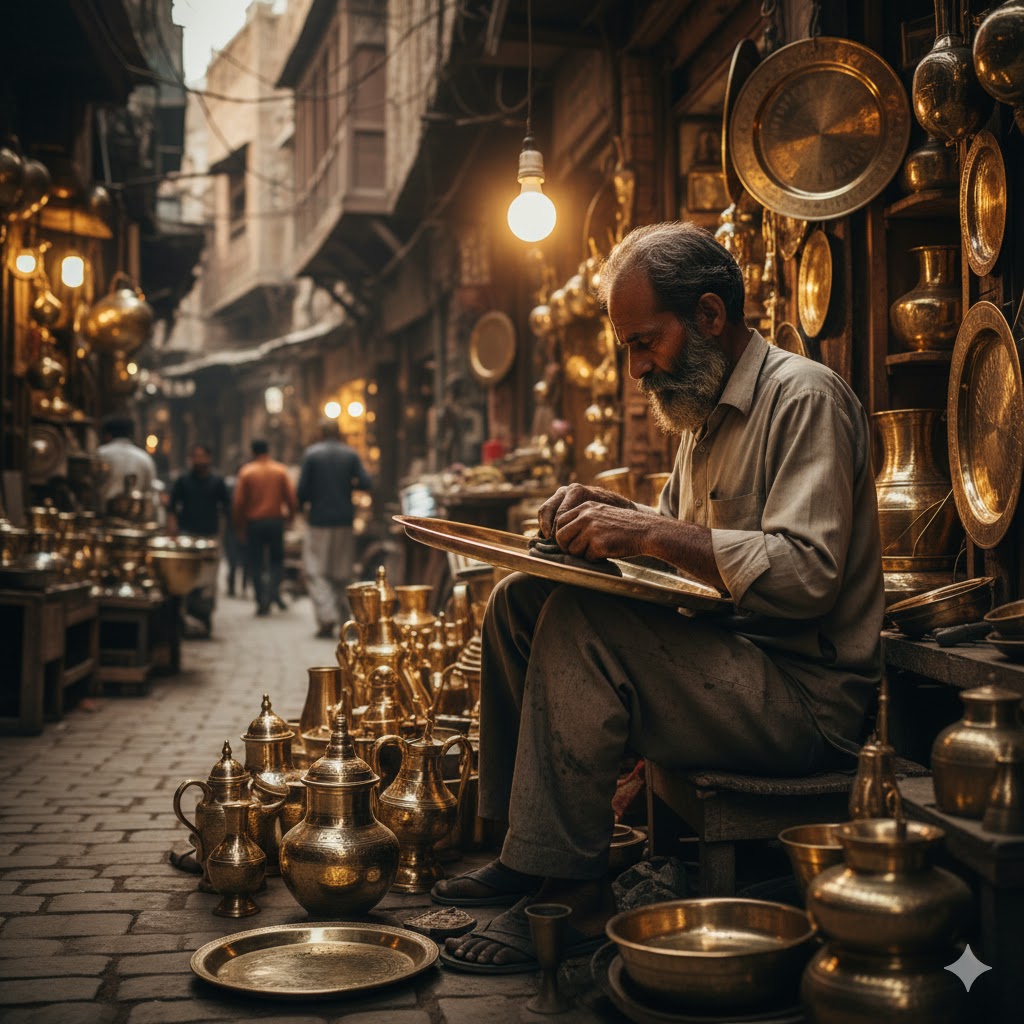
🎭 12. Best Time for the Historic Walks Lahore Walled City
The best months for Historic Walks Lahore Walled City are November–March. Morning tours capture soft sunlight on frescoes, while evenings glow with lanterns. For photographers, winter fog adds cinematic charm.
Every year, the Walled City of Lahore Authority hosts events like Heritage Walks, Basant Revival, and Mela Chiraghan photo exhibitions. These bring back Lahore’s forgotten cultural rhythm, attracting students, vloggers, and travelers.
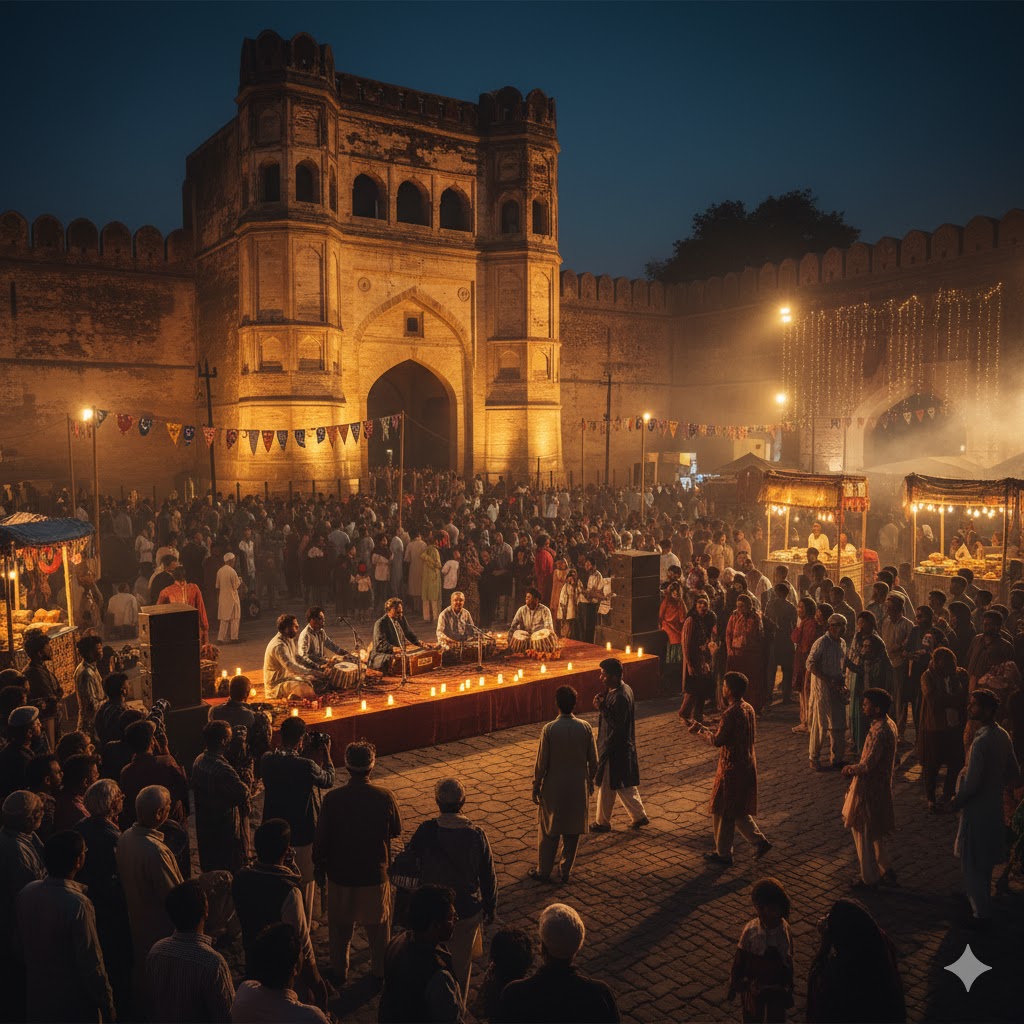
🕰️ 13. Best Time to Take a Historic Walk
The ideal months are November to March, when the weather is mild and skies are clear. Morning walks (8–11 AM) or evening tours (4–7 PM) provide the best lighting and comfort.
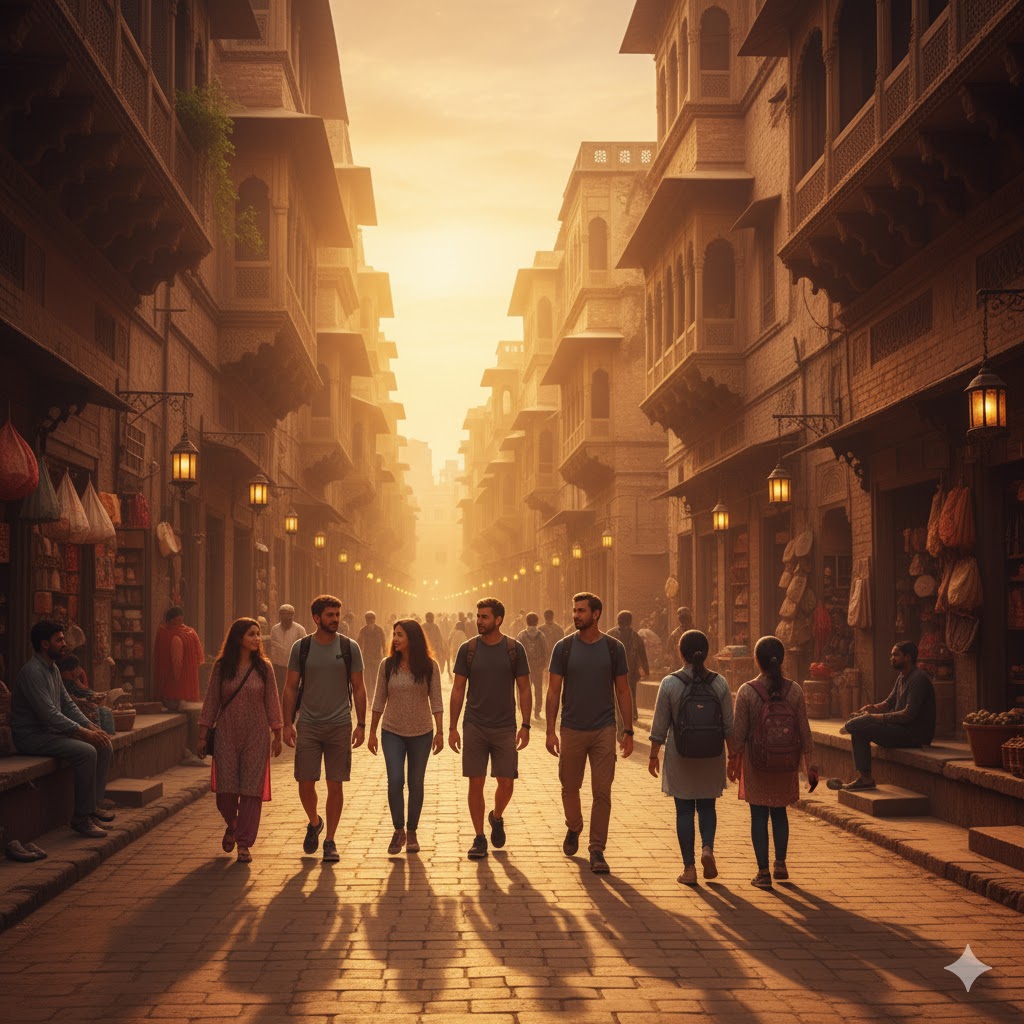
💼 14. Travel Tips & Passes
Etiquette: Respect local customs and dress modestly
Tickets: PKR 500–1000
Timings: 8 AM – 7 PM
Entry Points: Delhi Gate & Roshnai Gate
Guides: Always use certified WCLA guides
- Tickets: Heritage walks start at PKR 500–1000 depending on route length.
- Guide: Always hire WCLA-registered guides for authentic storytelling.
- Attire: Modest clothing and comfortable shoes recommended.
- Photography: Allowed but avoid drone use near heritage sites.
- Access: Entry from Delhi Gate or Roshnai Gate recommended.
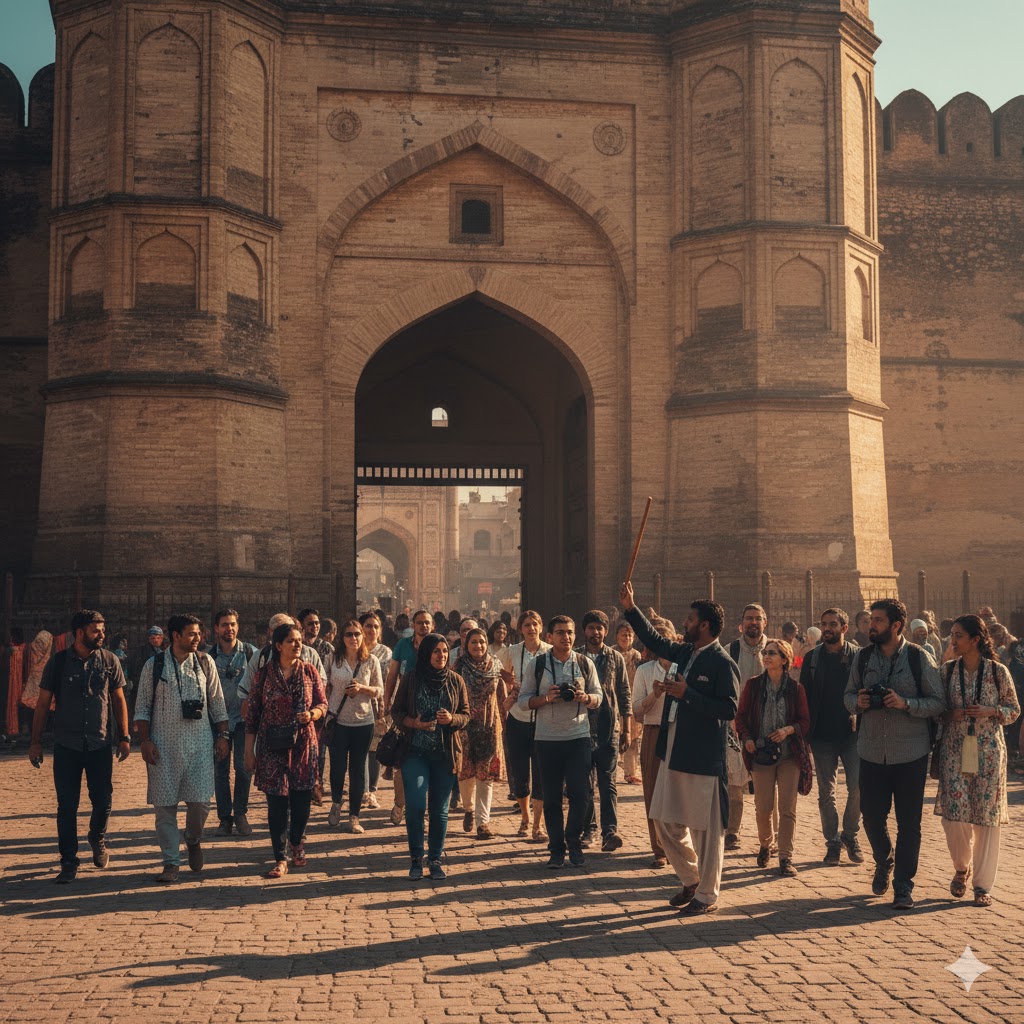
15. FAQs
- How long does a full Walled City walk take?
Around 3–4 hours, covering major landmarks and food spots. - Is it safe for solo travelers or students?
Yes, the area is patrolled and guided tours ensure safety. - What languages are guided tours available in?
English, Urdu, and Punjabi options are available. - Can international tourists visit without special permits?
Yes, no permit required — just bring your passport or ID. - Is photography allowed inside heritage buildings?
Yes, except for specific restricted chambers in the fort. - Are night walks available?
Yes, during heritage festivals and winter weekends. - What are must-try foods during the walk?
Seekh kebab, halwa puri, dahi bhallay, and lassi from Androon Lahore. - Can we visit all 13 gates in a single day?
Possible by rickshaw or on an extended full-day heritage walk.
Traveler Guide:
The Historic Walks Lahore Walled City offer more than sightseeing — they connect you to the very soul of South Asia’s heritage. From Mughal elegance to street poetry, food aromas to frescoed domes, every step whispers, “Lahore lives forever.”
